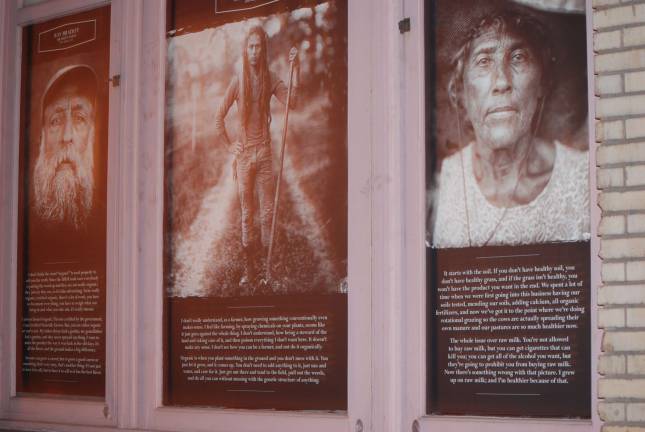Farmers lend gravitas to up-and-coming hot spot








Down where the brackish scent of sea mingles with that of overripe garbage on the corner and a stand-up bass wafts from a bar’s open window, where the storied Fulton Fish Market once dominated the dawn — you’ll find some familiar faces.
There’s Will Brown, who raises grass-fed cows at Lowland Farms in Warwick, leaning on a rake in front of a tractor wheel almost as tall as him. Jeff Bialis, of the family-run J&A Farm in Goshen, a scythe over his shoulder. Jay Uhler, one of the two dreadlocked young founders of Chester’s Peace and Carrots Farm, in the grassy middle of a dirt road. Eugene Wyatt, seated on a milk can among his flock at Catskill Merino Sheep Farm in Goshen.
The black-and-white photos, plastered over the ground floor windows of a vacant brick building at the corner of Manhattan’s Front and Beekman streets, are lifted from the coffee table book Organic: Farmers and Chefs of the Hudson Valley, by Francesco Mastalia. Mastalia, who recently moved from Warwick to Rhinebeck, drove 17,000 miles crisscrossing the Hudson Valley, photographing farmers, chefs and a monk who brews vinegar — plus two shots he took especially for the mural, of an orchardist and a jam-maker who vend at the farmers’ market that the mural promotes. His signature tool is the Civil War-era camera that requires Mastalia to produce photos in the field, and lends his subjects a gravitas that seems a relic of that bygone era.
The 21-photograph mural is the brainchild of Bob Lewis, a founder of the Union Square Greenmarket and now a consultant for the Howard Hughes Corporation, the developer that is turning the seaport luxe with 80 new shops and restaurants, a movie theater, a seafood restaurant by rockstar chef Jean-Georges Vongerichten, and a year-round indoor food market. The Fulton Stall Market is intended to be a community hub, connecting “farmers and producers with Lower Manhattan residents and workers,” a mural panel explains.
Waterfront food markets are having a moment: on an abandoned pier in the Hudson, TV chef Anthony Bourdain is opening a megamarket of international cuisine, “including fishmongers, butchers, bakers… a steaming noodle stall, a vibrant farmers’ market,” the NY Times reports.
Is there an irony in using dirt-stained faces to usher in a wave of gentrification? “It’s a platform for us to be able to see these farmers, to be able to hear their voices,” said Mastalia. “Public space is one of the best places to do this because maybe a person who might not go to a gallery will see this.”
John Gorzynski, of Gorzynski Ornery Farms in Narrowsburg, whose biblically lined and bearded face is writ large on the wall, wasn’t aware of the mural — “but I feel good about Francesco and what he’s doing,” he said. An organic pioneer, he gave up his certification when the USDA took over “and the definition was diminished to the point where… it didn’t come near to my standards,” he told Mastalia. Is he noticing extra attention, from the book or mural?
“I don’t pay too much attention,” he said wearily. “It’s all in the pursuit, trying to keep the government and corporates at bay, and make it so that we as humans can do what we are entitled to do, which is grow food for ourselves.”